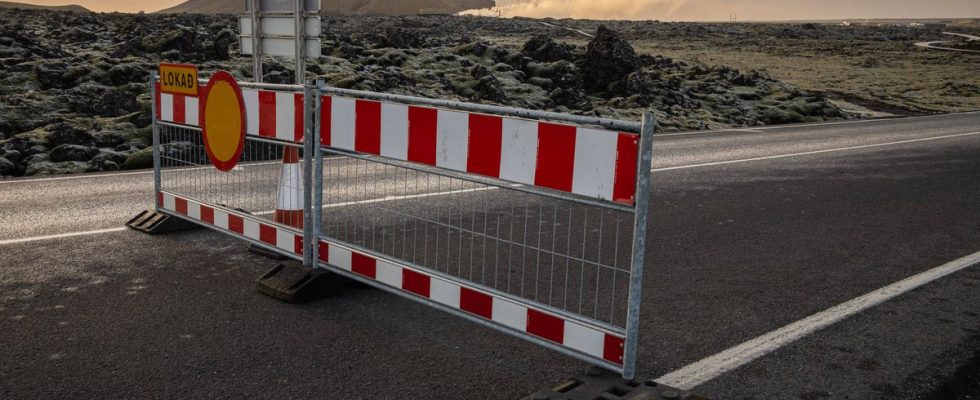In the next few days? In the night ? Even before ? What is certain, says Patrick Allard, volcanologist at theParis Institute of Globe Physics (CNRS), “a volcanic eruption is now inevitable” in the Reykjanes Peninsulain the southwest of Iceland, just a few dozen kilometers from Reykjavik, the capital.
Since the end of October, the region has faced significant seismic activity. The Icelandic Meteorological Institute (IMO) has recorded more than 23,000 earthquakes since October 25, with a sharp acceleration at the end of last week. 800 tremors were recorded on the morning of December 8 alone. Above all, beneath the surface, magma accumulates between 5 and 2 km depth, swelling the soils and cracking them with fractures. The Icelandic authorities took the lead by declaring a state of emergency on Friday, temporarily closing the “blue lagoon”, a famous spa resort, and ordering this weekend the evacuation of Grindavik, a town of 4,000 inhabitants under which the magma flows.
In regular contact with his Icelandic colleagues in recent hours, Patrick Allard deciphers the situation to 20 minutes.
What is this volcanic phenomenon that is currently threatening the Reykjanes Peninsula?
This is a so-called “fissurable” eruption. It is not linked to a volcano but to a system of fractures of the rock up to the surface, under the pressure of the magma which pushes into depth. This is not the first time that such a phenomenon has occurred on this Reykjanes peninsula. It is even the fourth since 2021. These magma infiltrations are due to the movement of the “mid-Atlantic” ridge, a large volcanic chain of 15,000 km which cross the Atlantic Ocean, from north to south, from which the “North American” and “European” plates move apart every year. These movements can create fissure eruptions.
What do we know about the situation in recent hours?
There is still no rash. But the magma is setting up, mainly since last Thursday with this strong acceleration of tremors; the strongest measured have a magnitude of 5.2. In recent hours, according to the information we have from Iceland, the seismicity has rather slowed down. There are fewer earthquakes, and they are less strong. There have been 900 since midnight, and they are now generally below magnitude 3. The rate of ground deformation has also slowed down somewhat.
All the same, to the west of Grindavik, this zone is already around fifteen kilometers long with faults sometimes found to be one meter deep. For the moment, the magma is mainly concentrated between 5 and 2 km from the surface. It remains very close, especially since the surface rocks are less resistant than those at depth. The magma should fracture them more easily and very quickly cross this last barrier. Potentially, the eruption could occur in the next few hours.
The Icelandic authorities seem to consider it a little more distant since, this Monday, they allowed certain residents of Grindavik to return to evacuate precious objects and livestock that could not be rescued.
The volcanic eruption seems inevitable today?
It’s hard to say when, but yes, she’s sure. The previous three episodes had all resulted in breakouts. We talked about it less because these phenomena took place far from inhabited areas. With the agreement of the authorities, Icelanders and passing tourists even went there to admire the eruptions and the lava rolling down the slopes.
The worry is much more appropriate this time. On the one hand, the infiltration of magma under the soil takes place a little further south and passes right through the middle of this port city of Grindavik and ends at sea. On the other hand, this episode is more powerful. The volume of magma is greater, it rises faster and over a greater length. It will most certainly not be gigantic and cataclysmic. However, the damage should be significant for Grindavik, an important port in the country. And 4,000 residents evacuated is not nothing in Iceland. That’s 1% of the population. The eruption could also damage other infrastructure in the region.
Added to this is the possibility of an eruption partly under the sea… Why is this to be feared?
We could indeed have more explosive phenomena caused by the interaction between the magma at around 1,200 °C and the cold temperature of the sea water. The fragmentation of the magma will be accentuated and could result in columns of ash released into the ‘atmosphere. These particles could then fall on a larger region than the Reykjanes Peninsula, including potentially Reykjavik, not so far away. The consequences could then be much more serious, particularly in a country like Iceland whose economy is largely based on agriculture and fishing.
Could this volcanic eruption have consequences well beyond Iceland like the eruption of Eyjafjakkajökull in 2010, which led to the largest closure of European skies in peacetime and led to the cancellation of 100,000 flights?
A priori no. In 2010, there was a volcanic eruption, 1,500 meters deep and with more viscous magma, richer in gas and therefore more explosive. This favored the emission of columns of ash. This time, we are at low altitude and on much more liquid magma, which flows rather than explodes.
But, as we have just said, the consequences could be more significant in the event of an underwater eruption. In this case, the impacts could be more significant and paralyze, for example, Reykjavik airport and perhaps also change the trajectories of other flights. Without, it seems to me, going so far as to disrupt global traffic as much as the 2010 eruption.

